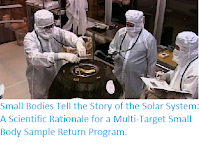Comet 141P/Machholz 2 reaches its perihelion (the closest point on its orbit to the Sun) on Wednesday 16 December 2020, when it will be approximately 0.81 AU from the Sun (i.e. 81% of the distance between the Earth and the Sun). At this time the comet will be 0.21 AU from the Earth, in the constellation of Aquarius, having a magnitude of 9.74, making visible with a good pair of binoculars or small telescope.
141P/Machholz 2 was discovered in August 1994 by Donald Machholz of Colfax, California. The designation 141P/ implies that it was the 141st Comet ever discovered, and that it is a periodic comet (P, again, most comets are periodic, but the term 'periodic comet' is reserved for those with periods of less than 200 years, since these can be reliably predicted), while the 2 indicates that it was the second comet discovered by Donald Machholz.
Comet 141P/Machholz 2 has an orbital period of 1918 days (5.25 years) and a highly eccentric orbit tilted at an angle of 12.8° to the plain of the Solar System, that brings it from 0.75 AU from the Sun at closest perihelion (75% of the distance between the Earth and the Sun; although the perihelion distance is variable and the comet does not come this close to the Sun on every orbit);to 5.28 AU from the Sun at aphelion (528 times as far from the Sun as the Earth or slightly inside the orbit of the planet Jupiter). As a comet with a period of less than 20 years with an orbit angled at less than 30° to the plane of the Solar System, 141P/Machholz 2 is considered to be a Jupiter Family Comet.
This means that 141P/Machholz 2 has occasional close
encounters with the Earth, with the
last thought to have happened in January 2000 and the next predicted
in December 2036. The asteroidalso
has occasional close encounters with the planets Venus, which it is next predicted to
pass in February 2079, and Jupiter, which it last came close to in October 2017 and is
expected to pass again in January 2030. Objects
which make close passes to multiple planets are considered to be in
unstable orbits, and are often eventually knocked out of these orbits by
these encounters, either being knocked onto a new, more stable orbit,
dropped into the Sun, knocked out of the Solar System or occasionally
colliding with a planet.
See also...



Follow Sciency Thoughts on Facebook.
Follow Sciency Thoughts on Twitter.





